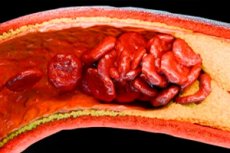New publications
Coronary atherosclerosis is common even in low-risk adults with normal cholesterol levels
Last reviewed: 02.07.2025

All iLive content is medically reviewed or fact checked to ensure as much factual accuracy as possible.
We have strict sourcing guidelines and only link to reputable media sites, academic research institutions and, whenever possible, medically peer reviewed studies. Note that the numbers in parentheses ([1], [2], etc.) are clickable links to these studies.
If you feel that any of our content is inaccurate, out-of-date, or otherwise questionable, please select it and press Ctrl + Enter.

In a recent study published in JACC Advances, US researchers examined the presence of coronary atherosclerosis using coronary computed tomography (CCTA) in asymptomatic adults without traditional risk factors, based on serum levels of low-density lipoprotein (LDL-C), non-high-density lipoprotein (non-HDL-C), and apolipoprotein B (apoB). The researchers found that coronary atherosclerosis is common and its incidence increases with increasing levels of atherogenic lipoproteins, even in low-risk adults without traditional risk factors.
Atherosclerotic cardiovascular disease (ASCVD) is a major cause of death worldwide, primarily due to coronary atherosclerosis, which is known to begin early and progress over time. Elevated LDL-C is a significant cause of ASCVD, and lowering LDL-C is important for prevention. Historically, LDL-C ≥160 mg/dL was considered elevated and <100 mg/dL was considered optimal. However, these levels may not be sufficient to prevent atherosclerosis or ASCVD. In addition, non-HDL-C and apoB are strong predictors of ASCVD, but are rarely assessed in asymptomatic populations. There is still little evidence linking these lipoproteins to coronary atherosclerosis in adults without clinical ASCVD or other risk factors.
The researchers used data from the Miami Heart Study (MiHeart), which included 1,033 participants aged 40–65 years without clinically significant cardiovascular disease or lipid-lowering therapy, with a subgroup of 184 participants having optimal risk factors. Individuals with high risk factors such as obesity, high creatinine, asthma, cancer, or pregnancy were excluded. The mean age of participants was 51 years, 42.1% were non-Hispanic white, and 55% were women. Data on demographics, clinical history, and CCTA were obtained. Coronary atherosclerosis was diagnosed using the Agatsson method and the American Heart Association classification.
Participants had mean serum LDL-C, non-HDL-C, and apoB levels of 125, 144, and 94 mg/dL, respectively. Most participants had a low predicted 10-year risk of ASCVD, with over 86% having a risk of <5%. Men had higher body mass index, atherogenic lipoprotein levels, and ASCVD risk than women. About 35.9% of participants without traditional ASCVD risk factors had coronary plaque, and the incidence of coronary and calcified plaque progressively increased with non-HDL-C, LDL-C, and apoB levels. Men had higher plaque scores and more high-risk characteristics than women.
The study shows that among asymptomatic, apparently healthy middle-aged U.S. adults without traditional risk factors for ASCVD, coronary atherosclerosis is common even with serum cholesterol levels considered normal. The incidence of the disease increases with increasing levels of LDL-C, non-HDL-C, and apoB. Despite the relatively rare high-risk plaque characteristics in this population, healthcare professionals should consider reducing atherogenic lipoprotein levels through diet, lifestyle modification, or drug therapy to potentially prevent or delay coronary atherosclerosis and improve patient health. Future research may focus on determining the best timing of risk assessment, the role of additional imaging, and the use of lipid-lowering therapy in low-risk individuals.
